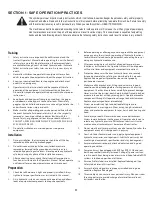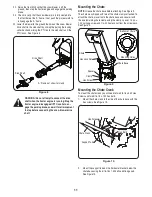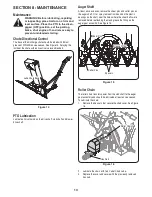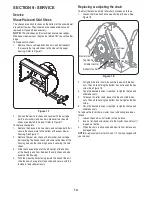
4
Keep bystanders, pets and children at least 75 feet from the
16.
machine while it is in operation. Stop machine if anyone enters the
area.
Exercise caution while operating tractor with this attachment,
17.
especially when traveling in reverse.
Thoroughly inspect the area where the equipment is to be used.
18.
Remove all door mats, sleds, boards, wires and any other foreign objects
which could be thrown by the auger/impeller.
Always wear safety glasses or eye shields during operation and while
19.
performing an adjustment or repair to protect your eyes. Thrown
objects which ricochet can cause serious injury to the eyes.
Do not operate without wearing adequate winter outer garments.
20.
Do not wear jewelry, long scarves or other loose clothing which could
become entangled in moving parts. Wear footwear which will improve
footing on slippery surfaces.
To avoid personal injury or property damage use extreme care in
21.
handling gasoline. Gasoline is extremely flammable and the vapors are
explosive. Serious personal injury can occur when gasoline is spilled on
yourself or your clothes which can ignite. Wash your skin and change
clothes immediately.
Use only an approved gasoline container.
a.
Never fill containers inside a vehicle or on a truck or trailer bed
b.
with a plastic liner. Always place containers on the ground, away
from your vehicle, before filling.
When practical, remove gas-powered equipment from the truck
c.
or trailer and refuel it on the ground. If this is not possible, then
refuel such equipment on a trailer with a portable container,
rather than from a gasoline dispenser nozzle.
Keep the nozzle in contact with the rim of the fuel tank or
d.
container opening at all times, until refueling is complete. Do not
use a nozzle lock-open device.
Extinguish all cigarettes, cigars, pipes and other sources of
e.
ignition.
Never fuel machine indoors.
f.
Never remove gas cap or add fuel while the engine is hot or
g.
running.
Allow engine to cool at least two minutes before refueling.
h.
Never over fill fuel tank. Fill tank to no more than ½ inch below
i.
bottom of filler neck to provide space for fuel expansion.
Replace gasoline cap and tighten securely.
j.
If gasoline is spilled, wipe it off the engine and equipment. Move
k.
machine to another area. Wait 5 minutes before starting the
engine.
Never store the machine or fuel container inside where there
l.
is an open flame, spark or pilot light (e.g. furnace, water heater,
space heater, clothes dryer etc.).
Allow machine to cool at least 5 minutes before storing.
m.
14.
Adjust collector housing height to clear gravel or crushed rock surfaces.
15.
Disengage all clutches and shift into neutral before starting the engine.
16.
Never attempt to make any adjustments while engine is running, except
17.
where specifically recommended in the operator’s manual(s).
Let tractor engine and attachment adjust to outdoor temperature
18.
before starting to clear snow.
Operational
Do not allow other people in the area when operating,
1.
attaching, removing, assembling or servicing equipment;
particularly small children.
Improper use of a snow thrower can cause injury or death.
2.
Do not put hands or feet near or under rotating parts, in the
3.
auger/impeller housing or discharge chute. Keep clear of the
discharge opening at all times. Contact with the rotating parts
can amputate hands and feet.
Never operate with a missing or damaged discharge chute. Keep
4.
all safety devices in place and working.
When cleaning, repairing or inspecting the snow thrower,
5.
make certain the collector/impeller and all moving parts have
stopped. Disengage the power take-off, lower attachment,
set the parking brake and stop engine before you leave the
operating position. . Do not run the engine indoors, except
when starting the engine and for transporting the snow thrower
in or out of the building. Open the outside doors; exhaust fumes
are dangerous.
Do not operate machine while under the influence of alcohol or
6.
drugs.
Exercise extreme caution when operating on or crossing gravel
7.
surfaces. Stay alert for hidden hazards or traffic.
Exercise caution when changing direction and while operating
8.
on slopes.
Do not clear snow across the face of slopes; go up and down.
9.
Exercise extreme caution when operating on slopes. Do not
attempt to clear steep slopes.
Plan your snow throwing pattern to avoid discharge towards
10.
windows, walls, cars etc. To avoid property damage or personal
injury caused by a ricochet.
Never direct discharge at children, bystanders and pets or allow
11.
anyone in front of the machine.
Do not overload machine capacity by attempting to clear snow
12.
at too fast of a rate.
Never operate this machine without good visibility or light.
13.
Disengage power to the auger/impeller when transporting or
14.
not in use.
Never operate machine at high transport speeds on slippery
15.
surfaces. Look down and behind and use care when in reverse.
If the machine should start to vibrate abnormally, stop the
16.
engine, disengage the power take-off, lower the attachment
and set the parking brake. Inspect thoroughly for damage.
Repair any damage before starting and operating.
After striking a foreign object, stop the engine, remove the
17.
wire from the spark plug, thoroughly inspect the snow thrower
for any damage, and repair the damage before restarting and
operating the snow thrower.
Disengage the power take-off, lower attachment, set the
18.
parking brake and stop engine before you leave the operating
position. Wait until the auger/impeller comes to a complete
stop before unclogging the discharge chute, making any
adjustments, or inspections. Remove the key if leaving the
machine unattended.
Do not carry passengers.
19.
If situations occur which are not covered in this manual, use care
20.
and good judgment. Contact your dealer or telephone 1-(877)
282-5055 for assistance and the name of your nearest servicing
dealer.
Summary of Contents for 59A40051727
Page 17: ...17 Notes page ...





































